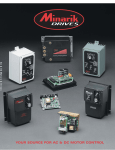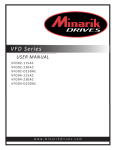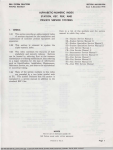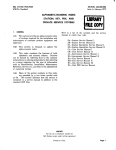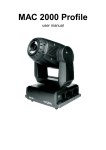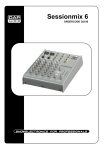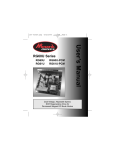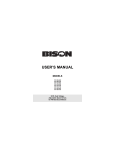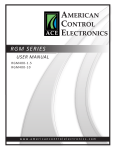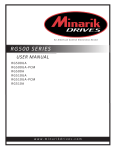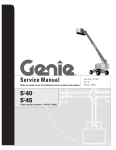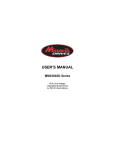Download User`s Manual
Transcript
250-0249r6.qxp 10/1/2004 9:05 AM Page a Models: C1RGD03-D230AC C1RGD10-D230AC MMRGD03-D230AC MMRGD03-D230AC-PCM MMRGD10-D230AC MMRGD10-D230AC-PCM Digital SCR Regen, Variable-Speed DC Drives User’s Manual RGD Series 250-0249r6.qxp 10/1/2004 9:05 AM Page b Copyright © 2002 by Minarik Corporation All rights reserved. No part of this manual may be reproduced or transmitted in any form without written permission from Minarik Corporation. The information and technical data in this manual are subject to change without notice. Minarik Corporation and its Divisions make no warranty of any kind with respect to this material, including, but not limited to, the implied warranties of its merchantability and fitness for a given purpose. Minarik Corporation and its Divisions assume no responsibility for any errors that may appear in this manual and make no commitment to update or to keep current the information in this manual. Printed in the United States of America. 250-0249r6.qxp 10/1/2004 9:05 AM Page i i Safety Warnings • This symbol denotes an important safety tip or warning. SHOCK HAZARD AVOID HEAT KEE DR OID ATION Please read these instructions carefully before performing any of the procedures contained in this manual. • DO NOT INSTALL, REMOVE, OR REWIRE THIS EQUIPMENT WITH POWER APPLIED. Have a qualified electrical technician install, adjust and service this equipment. Follow the National Electrical Code and all other applicable electrical and safety codes, including the provisions of the Occupational Safety and Health Act (OSHA), when installing equipment. • Reduce the chance of an electrical fire, shock, or explosion by proper grounding, over-current protection, thermal protection, and enclosure. Follow sound maintenance procedures. It is possible for a drive to run at full speed as a result of a component failure. Minarik strongly recommends the installation of a master switch in the main power input to stop the drive in an emergency. Circuit potentials are at 115 VAC or 230 VAC above earth ground. Avoid direct contact with the printed circuit board or with circuit elements to prevent the risk of serious injury or fatality. Use a non-metallic screwdriver for adjusting the calibration trimpots. Use approved personal protective equipment and insulated tools if working on this drive with power applied. 250-0249r6.qxp 10/1/2004 9:05 AM Page ii ii Table of Contents Safety Warnings Regenerative Drives i vii Specifications 1 Dimensions 2 Installation 7 Drive mounting (General) . . . . . . . . . . . . . . . . . . . . . . . . . . . . . . . . . . . . . . . . . .7 Drive mounting (MMRGD) . . . . . . . . . . . . . . . . . . . . . . . . . . . . . . . . . . . . . . . . .7 Drive mounting (C1RGD) . . . . . . . . . . . . . . . . . . . . . . . . . . . . . . . . . . . . . . . . . .8 Wiring . . . . . . . . . . . . . . . . . . . . . . . . . . . . . . . . . . . . . . . . . . . . . . . . . . . . . . . . .10 Shielding guidelines . . . . . . . . . . . . . . . . . . . . . . . . . . . . . . . . . . . . . . . . . . . .11 Heat sinking . . . . . . . . . . . . . . . . . . . . . . . . . . . . . . . . . . . . . . . . . . . . . . . . . . .12 Line fusing . . . . . . . . . . . . . . . . . . . . . . . . . . . . . . . . . . . . . . . . . . . . . . . . . . . .12 Speed adjust potentiometer installation . . . . . . . . . . . . . . . . . . . . . . . . . . . . . . .14 Speed adjust potentiometer connections . . . . . . . . . . . . . . . . . . . . . . . . . . . .15 MMRGD . . . . . . . . . . . . . . . . . . . . . . . . . . . . . . . . . . . . . . . . . . . . . . . . . .15 CIRGD . . . . . . . . . . . . . . . . . . . . . . . . . . . . . . . . . . . . . . . . . . . . . . . . . . .15 Connections . . . . . . . . . . . . . . . . . . . . . . . . . . . . . . . . . . . . . . . . . . . . . . . . . . . .17 MMRGD . . . . . . . . . . . . . . . . . . . . . . . . . . . . . . . . . . . . . . . . . . . . . . . . . .17 Motor . . . . . . . . . . . . . . . . . . . . . . . . . . . . . . . . . . . . . . . . . . . . . . . . . .17 Power input . . . . . . . . . . . . . . . . . . . . . . . . . . . . . . . . . . . . . . . . . . . . .18 Line fuse . . . . . . . . . . . . . . . . . . . . . . . . . . . . . . . . . . . . . . . . . . . . . . .18 C1RGD . . . . . . . . . . . . . . . . . . . . . . . . . . . . . . . . . . . . . . . . . . . . . . . . . .21 Motor . . . . . . . . . . . . . . . . . . . . . . . . . . . . . . . . . . . . . . . . . . . . . . . . . .21 Power input . . . . . . . . . . . . . . . . . . . . . . . . . . . . . . . . . . . . . . . . . . . . .21 Selector switches . . . . . . . . . . . . . . . . . . . . . . . . . . . . . . . . . . . . . . . . . . . . . . .24 Voltage selector (SW501, SW502) . . . . . . . . . . . . . . . . . . . . . . . . . . . . . . .24 Feedback selector (SW503) . . . . . . . . . . . . . . . . . . . . . . . . . . . . . . . . . . . .24 Armature voltage selector (SW504) . . . . . . . . . . . . . . . . . . . . . . . . . . . . . . .24 250-0249r6.qxp 10/1/2004 9:05 AM Page iii Contents iii Voltage follower . . . . . . . . . . . . . . . . . . . . . . . . . . . . . . . . . . . . . . . . . . . . . . . .27 MMRGD . . . . . . . . . . . . . . . . . . . . . . . . . . . . . . . . . . . . . . . . . . . . . . . . . .27 C1RGD . . . . . . . . . . . . . . . . . . . . . . . . . . . . . . . . . . . . . . . . . . . . . . . . . .27 Operation 28 Before applying power . . . . . . . . . . . . . . . . . . . . . . . . . . . . . . . . . . . . . . . . . . .28 MMRGD drive startup . . . . . . . . . . . . . . . . . . . . . . . . . . . . . . . . . . . . . . . . . . . .29 To start the drive . . . . . . . . . . . . . . . . . . . . . . . . . . . . . . . . . . . . . . . . . . .29 MMRGD drive shutdown . . . . . . . . . . . . . . . . . . . . . . . . . . . . . . . . . . . . . . . . . .29 C1RGD drive startup . . . . . . . . . . . . . . . . . . . . . . . . . . . . . . . . . . . . . . . . . . . .30 To start the drive . . . . . . . . . . . . . . . . . . . . . . . . . . . . . . . . . . . . . . . . . . .30 C1RGD drive shutdown . . . . . . . . . . . . . . . . . . . . . . . . . . . . . . . . . . . . . . . . . .30 Starting and Stopping Methods . . . . . . . . . . . . . . . . . . . . . . . . . . . . . . . . . . . . .31 Line starting and stopping . . . . . . . . . . . . . . . . . . . . . . . . . . . . . . . . . . . . . .31 Decelerate to a stop (MMRGD) . . . . . . . . . . . . . . . . . . . . . . . . . . . . . . . . . .32 Regenerative braking (MMRGD) . . . . . . . . . . . . . . . . . . . . . . . . . . . . . . . . .33 INHIBIT mode (MMRGD) . . . . . . . . . . . . . . . . . . . . . . . . . . . . . . . . . . . . . . .34 Disable/Enable terminals (MMRGD) . . . . . . . . . . . . . . . . . . . . . . . . . . . . . .35 Regenerative braking (C1RGD) . . . . . . . . . . . . . . . . . . . . . . . . . . . . . . . . . .36 Diagnostic LEDs . . . . . . . . . . . . . . . . . . . . . . . . . . . . . . . . . . . . . . . . . . . . . . . .37 Calibration 40 Minimum Speed (MIN SPD) . . . . . . . . . . . . . . . . . . . . . . . . . . . . . . . . . . . . . . . .42 Maximum Speed (MAX SPD) . . . . . . . . . . . . . . . . . . . . . . . . . . . . . . . . . . . . . .42 Forward Torque (FWD TQ) . . . . . . . . . . . . . . . . . . . . . . . . . . . . . . . . . . . . . . . .43 Reverse Torque (REV TQ) . . . . . . . . . . . . . . . . . . . . . . . . . . . . . . . . . . . . . . . . .44 IR Compensation (IR COMP) . . . . . . . . . . . . . . . . . . . . . . . . . . . . . . . . . . . . . .46 Forward Acceleration (FWD ACC) . . . . . . . . . . . . . . . . . . . . . . . . . . . . . . . . . .47 Reverse Acceleration (REV ACC) . . . . . . . . . . . . . . . . . . . . . . . . . . . . . . . . . .47 Tachogenerator (TACH) . . . . . . . . . . . . . . . . . . . . . . . . . . . . . . . . . . . . . . . . . .48 Signal Adjustment (SIGNAL ADJUST) . . . . . . . . . . . . . . . . . . . . . . . . . . . . . . .49 Application Notes . . . . . . . . . . . . . . . . . . . . . . . . . . . . . . . . . . . . . . . . . . . . . .51 Connection to DLC600 . . . . . . . . . . . . . . . . . . . . . . . . . . . . . . . . . . . . . . . . . . .51 Optional speed adjust potentiometer connections to MMRGD series drives . .52 Independent Adjustable Speeds (Forward Direction Only) . . . . . . . . . . . . . . . .53 250-0249r6.qxp iv 10/1/2004 9:05 AM Page iv Contents Table of Contents (cont.) Independent Forward and Reverse Speeds . . . . . . . . . . . . . . . . . . . . . . . . . . .54 Independent Forward and Reverse Speeds With FWD-STOP-REV Switch . . . . . . . . . . . . . . . . . . . . . . . . . . . . . . . . . . . . . . .55 Troubleshooting 56 Before troubleshooting . . . . . . . . . . . . . . . . . . . . . . . . . . . . . . . . . . . . . . . . . . .56 Replacement Parts . . . . . . . . . . . . . . . . . . . . . . . . . . . . . . . . . . . . . . . . . . . . . .59 Unconditional Warranty Inside Back Cover Tables Table 1. Recommended Line Fuse Sizes . . . . . . . . . . . . . . . . . . . . . . . . . . . . . .13 Table 2. Replacement Parts . . . . . . . . . . . . . . . . . . . . . . . . . . . . . . . . . . . . . . . . .59 250-0249r6.qxp 10/1/2004 9:05 AM Page v v Illustrations Figure 1. Four-Quadrant Operation . . . . . . . . . . . . . . . . . . . . . . . . . . . . . . . . . . .viii Figure 2. MMRGD Dimensions . . . . . . . . . . . . . . . . . . . . . . . . . . . . . . . . . . . . . . . .2 Figure 3. MMRGD Dimensions with drive mounted on 223-0159 heat sink . . . . . .3 Figure 4. MMRGD-PCM Dimensions . . . . . . . . . . . . . . . . . . . . . . . . . . . . . . . . . . .4 Figure 5. C1RGD Dimensions . . . . . . . . . . . . . . . . . . . . . . . . . . . . . . . . . . . . . . . . .5 Figure 6. Heat Sink Dimensions . . . . . . . . . . . . . . . . . . . . . . . . . . . . . . . . . . . . . . .6 Figure 7. C1RGD Mounting Hole Locations . . . . . . . . . . . . . . . . . . . . . . . . . . . . . .9 Figure 8. MMRGD Speed Adjust Potentiometer . . . . . . . . . . . . . . . . . . . . . . . . . .14 Figure 9. MMRGD Speed Adjust Potentiometer Connections . . . . . . . . . . . . . . .16 Figure 10. MMRGD Power, Motor and Fuse Connections (Bottom Board) . . . . . . . . . . . . . . . . . . . . . . . . . . . . . . . . . . . . . . . . . . .19 Figure 11. MMRGD-PCM Connections . . . . . . . . . . . . . . . . . . . . . . . . . . . . . . . . .20 Figure 12. C1RGD Power and Motor Connections . . . . . . . . . . . . . . . . . . . . . . . .22 Figure 13. C1RGD Front Panel Switch Connections . . . . . . . . . . . . . . . . . . . . . .23 Figure 14. MMRGD Selector Switch Locations . . . . . . . . . . . . . . . . . . . . . . . . . . .25 Figure 15. C1RGD Selector Switch Locations . . . . . . . . . . . . . . . . . . . . . . . . . . .26 Figure 16. MMRGD Voltage Follower Connection . . . . . . . . . . . . . . . . . . . . . . . .27 Figure 17. RUN/STOP Switch . . . . . . . . . . . . . . . . . . . . . . . . . . . . . . . . . . . . . . . .32 Figure 18. MMRGD Regenerative Brake Terminals With Optional RUN/BRAKE Switch . . . . . . . . . . . . . . . . . . . . . . . . . . .33 Figure 19. Inhibit Terminals Showing Optional Switch Installation . . . . . . . . . . . .34 Figure 20. Enable/Disable Terminals Showing Optional Switch Installation . . . . . . . . . . . . . . . . . . . . . . . . . . . . . . . . .35 Figure 21. C1RGD Front Panel Switch Layout . . . . . . . . . . . . . . . . . . . . . . . . . . .36 Figure 22. MMRGD Diagnostic LED Location . . . . . . . . . . . . . . . . . . . . . . . . . . .38 Figure 23. C1RGD Diagnostic LED Location . . . . . . . . . . . . . . . . . . . . . . . . . . . .39 250-0249r6.qxp 10/1/2004 9:05 AM Page vi vi Illustrations (cont.) Figure 24. Calibration Trimpot Layout . . . . . . . . . . . . . . . . . . . . . . . . . . . . . . . . . .41 Figure 25. Recommended IR COMP, REVERSE TORQUE and FORWARD TORQUE Settings . . . . . . . . . . . . . . . . . . . . . . . . . . . . . . . . . . . . . . . .50 Figure 26. MMRGD Connection to DLC600 . . . . . . . . . . . . . . . . . . . . . . . . . . . . .51 Figure 27. Forward-Reverse Switch . . . . . . . . . . . . . . . . . . . . . . . . . . . . . . . . . . .52 Figure 28. Forward-Stop-Reverse Switch . . . . . . . . . . . . . . . . . . . . . . . . . . . . . . .52 Figure 29. Independent Adjustable Speeds (Forward Direction) . . . . . . . . . . . . . . . . . . . . . . . . . . . . . . . . . . . . . . .53 Figure 30. Independent Forward and Reverse Speeds . . . . . . . . . . . . . . . . . . . .54 Figure 31. Independent Forward and Reverse Speeds with a Forward-Stop-Reverse Switch . . . . . . . . . . . . . . . . . . . . . . . . . . . . . . .55 250-0249r6.qxp 10/1/2004 9:05 AM Page vii vii Regenerative Drives Most non-regenerative variable-speed DC drives control current flow to a motor in one direction. The direction of current flow is the same direction as the motor rotation. Non-regenerative drives operate in Quadrant 1 and Quadrant 3 if the drive is reversible (see Figure 1, page viii). Motors must stop before reversing direction. Unless dynamic braking is used, non-regenerative drives cannot decelerate a load faster than coasting to a lower speed. Regenerative drives operate in two additional quadrants: Quadrant 2 and Quadrant 4. In these quadrants, motor torque is in the opposite direction of motor rotation. Regenerative drives can reverse a motor without contactors, switches, brake resistors and inhibit plugs. They can also control an overhauling load and decelerate a load faster than it would take to coast to a lower speed. 250-0249r6.qxp viii 10/1/2004 9:05 AM Page viii Regenerative Drives Quadrant II Quadrant I Quadrant III Quadrant IV MOTOR ROTATION MOTOR TORQUE NOTE: ARROWS IN SAME DIRECTION = MOTOR ACTION ARROWS IN OPPOSITE DIRECTION = REGENERATIVE ACTION Figure 1. Four-Quadrant Operation 250-0249r6.qxp 10/1/2004 9:05 AM Page 1 1 Specifications Maximum Armature Current (DC Amps) Horsepower Range (115 VAC Input) Horsepower Range (230 VAC Input) C1RGD03-D230AC 3.0 1/20 – 1/4 1/10 – 1/2 0 – 180 C1RGD10-D230AC* 5.0 1/4 – 1/2 1/2 – 1 0 – 180 MMRGD03-D230AC 3.0 1/10 – 1/4 1/10 – 1/2 0 – 180 MMRGD03-D230AC-PCM 3.0 1/10 – 1/4 1/10 – 1/2 0 – 180 MMRGD10-D230AC** 5.0 1/4 – 1/2 1/2 – 1 0 – 180 MMRGD10-D230AC-PCM** 5.0 1/4 – 1/2 1/2 – 1 0 – 180 Model Armature Voltage Range † (DC Volts) † With 230 VAC applied; 0 – 90 VDC with 115 VAC applied. * When mounted to heat sink kit part number 223–0355, the maximum armature current increases to 10 ADC and maximum horspower increases to 1 HP (115 VAC input) or 2 HP (230 VAC input). ** When mounted to heat sink kit part number 223–0159, the maximum armature current increases to 10 ADC and maximum horsepower increases to 1 HP (115 VAC input) or 2 HP (230 VAC input). AC Line Voltage 115/230 VAC ±10%, 50/60 Hz, single phase Form Factor 1.37 at base speed Acceleration Time Range 0.5 – 6 seconds Deceleration Time Range 0.5 – 6 seconds Analog Input Voltage Range (signal must be isolated; S0 to S2) -10 VDC to +10VDC PCM Model Analog Input Voltage Range Input Impedance (S0 to S2) PCM Model Input Impedance (POS to NEG) Load Regulation Vibration 0 - 10 VDC 30 kΩ 1 kΩ 1% base speed 0.5G max. (20–50 Hz) Ambient Temperature Range (chassis drives) 10°C–55°C Ambient Temperature Range (enclosed drives) 10°C–40°C Weight 1.1 lb 250-0249r6.qxp 10/1/2004 9:05 AM Page 2 2 10 1 S0 2 IC503 9 RB2 SO502 S1 IC504 0.99 [25] RB1/COM Dimensions 0.188 [4.8] S2 RB3 IC50 RB4 S3 Y501 REV 3.72 [94] 1.75 [44] IC501 REV TQ FWD LIM -15V COM SW502 115 SW504 T1 TACH T2 0.188 [4.8] 2.87 [73] 1.50 [38] 0.96 [24] 3.80 [97] 4.30 [109] 4.42[112] ALL DIMENSIONS IN INCHES [MILLIMETERS] Figure 2. MMRGD Dimensions 250-0249r6.qxp 10/1/2004 9:05 AM Page 3 Dimensions 3 6.90 [175] 6.30 [160] S0 IC503 IC504 RB1/COM 5.90 [150] 0.188 [4.8 RB4 RB2 SO502 0.70 [18] IC501 T2 3.70 [94] SW501 ARMATURE -15V COM 115 +15V 4.40 [112] 0.70 [18] 3.87 [98] 1.00 [25] 0.13 [3] ALL DIMENSIONS IN INCHES [MILLIMETERS] Figure 3. MMRGD Dimensions with drive mounted on 223-0159 heat sink 250-0249r6.qxp 4 10/1/2004 9:05 AM Page 4 Dimensions IC503 IC504 0.99 [25] TB502 RB4 RB3 RB2 P501 RB1/ COM T501 1.75 [44] TB503 3.72 [94] 4 RB4 3 RB3 2 RB2 1 RB1/ COM 4 DIR 3 COM 2 TACH 90 4.10 [104] NEG 1 POS TB501 3.40 [86] 0.188 [4.8] 0.96 [24] 4.30 [109] 4.42 [112] ALL DIMENSIONS IN INCHES [MILLIMETERS] Figure 4. MMRGD-PCM Dimensions 250-0249r6.qxp 10/1/2004 9:05 AM Page 5 Dimensions 6.00 [152] 40 50 60 30 70 20 80 10 90 0 100 8.00 [203] 3.46 [88] 2.75 [70] 1.25 [32] 1.72 [44] 2.50 [64] ALL DIMENSIONS IN INCHES [MILLIMETERS] Figure 5. C1RGD Dimensions 5 250-0249r7.qxp 6 1/24/2005 2:20 PM Page 6 Dimensions 6.90 [175] 6.30 [160] 5.90 [150] C A D B E MOUNTING SLOTS 0.19 X 0.34 [5 X 9] ALL DIMENSIONS IN INCHES [MILLIMETERS] PART NO. DIM “A” DIM “B” DIM “C” DIM “D” DIM “E” 223-0159 4.40 [112] 3.00 [76] 0.7 [18] 1.75 [44] 3.90 [100] 223-0174 7.78 [198] 6.00 [152] 0.89 [23] 6.00 [152] 5.35 [136] Heat sinks sold separately. Figure 6. Heat Sink Dimensions 250-0249r6.qxp 10/1/2004 9:05 AM Page 7 Installation 7 Installation Drive mounting (General) • Drive components are sensitive to electrostatic fields. Avoid direct contact with the circuit board. • Protect the drive from dirt, moisture, and accidental contact. • Provide sufficient room for access to the terminal block and calibration trimpots. • Mount the drive away from heat sources. Operate the drive within the specified ambient operating temperature range. • Prevent loose connections by avoiding excessive vibration of the drive. Drive mounting (MMRGD) • Mount the drive with its board in either a horizontal or vertical plane. Eight (8) 0.188 inch [4.8 mm] wide slots in the chassis accept #8 pan head screws. Fasten either the large base or the narrow flange of the chassis to the subplate. • The drive must be earth grounded for noise suppression. Connect earth ground to the earth ground terminal on the drive’s bottom board (see Figure 10, page 19, for location). 250-0249r6.qxp 8 10/1/2004 9:05 AM Page 8 Installation Drive mounting (C1RGD) C1RGD drives come with two (2) 0.88 inch [22 mm] conduit holes at the bottom of the case. Units without a heatsink (5 ADC or below) may be vertically wall mounted or horizontally bench mounted using the three keyholes on the back of the case. See Figure 7 (page 9) for mounting hole locations of C1RGD controls without a heatsink. For mounting of C1RGD controls with a heatsink (over 5 ADC) the four (4) 0.188 inch [4.8 mm] wide slots in the heatsink. The slots accept #8 pan head screws. See Figure 6 (page 6) for mounting slot locations. 1. For access to the keyholes and the terminal strip, remove the two screws from the front of the case by turning them counterclockwise. Grasp the front cover and lift it straight out. 2. Install the mounting screws in the three keyholes. 3. Install conduit hardware through the conduit holes at the bottom of the case. Connect external wiring to the terminal block. 4. Reinstall the front cover. Avoid pinching any wires between the front cover and the case. 5. Replace the two screws to the front cover. Turn the screws clockwise to tighten. 250-0249r6.qxp 10/1/2004 9:06 AM Page 9 Installation 6.00 [152] KEYHOLES FOR #10 SCREW ON BACKSIDE FOR MOUNTING (3 PLACES) 1.79 [45.0] 8.00 [203] 5.00 [127] HEATSINK MOUNTING HOLES (4 PLACES) TWO 0.88 [22.0] CONDUIT HOLES ON BOTTOM SIDE 3.46 [88.0] 1.25 [32] 6.00 [152] 2.50 [64.0] ALL MEASUREMENTS IN INCHES [MILLIMETERS] Figure 7. C1RGD Mounting Hole Locations 9 250-0249r6.qxp 10 10/1/2004 9:06 AM Page 10 Installation Wiring Warning Do not install, remove, or rewire this equipment with power applied. Failure to heed this warning may result in fire, explosion, or serious injury. Circuit potentials are at 115 or 230 VAC above ground. To prevent the risk of injury or fatality, avoid direct contact with the printed circuit board or with circuit elements. Do not disconnect any of the motor leads from the drive unless power is removed or the drive is disabled. Opening any one motor lead may destroy the drive. • Use 18 AWG wire for speed adjust potentiometer wiring. Use 16 AWG wire for AC line (L1, L2) and motor (A1, A2) wiring. 250-0249r6.qxp 10/1/2004 9:06 AM Page 11 Installation 11 Shielding guidelines Warning Under no circumstances should power and logic leads be bundled together. Induced voltage can cause unpredictable behavior in any electronic device, including motor controls. As a general rule, Minarik recommends shielding of all conductors. If it is not practical to shield power conductors, Minarik recommends shielding all logic-level leads. If shielding of logic leads is not practical, the user should twist all logic leads with themselves to minimize induced noise. It may be necessary to earth ground the shielded cable. If noise is produced by devices other than the drive, ground the shield at the drive end. If noise is generated by a device on the drive, ground the shield at the end away from the drive. Do not ground both ends of the shield. If the drive continues to pick up noise after grounding the shield, it may be necessary to add AC line filtering devices, or to mount the drive in a less noisy environment. Logic wires from other input devices, such as motion controllers and PLL velocity controllers, must be separated from power lines in the same manner as the logic I/O on this drive. 250-0249r6.qxp 12 10/1/2004 9:06 AM Page 12 Installation Heat sinking MMRGD10 series drives require heat sink kit 223-0159 when the continuous armature current is above 5 ADC. C1RGD10 series drives require heat sink kit 223-0355 when the continuous armature current is above 5 ADC. MMRGD03 and C1RGD03 series drives do not require an additional heat sink. Refer to Figure 6 (page 6) for C1RGD heat sink mounting hole locations. Use a thermally conductive heat sink compound (such as Dow Corning® 340 Heat Sink compound) between the drive chassis and the heat sink surface for optimum heat transfer. Line fusing Minarik drives require fuses for protection. Use fast acting fuses rated for 250 VAC or higher and approximately 150% of the maximum armature current. Install a fuse on L1 if the input is 115 VAC. Fuse both L1 and L2 when the line voltage is 230 VAC. The C1RGD drive is pre-wired with two internal 5A fuses (for C1RGD03 drives), or two 15A fuses (for C1RGD10 drives). Table 1 lists the recommended line fuse sizes. 250-0249r6.qxp 10/1/2004 9:06 AM Page 13 13 Installation Table 1. Recommended Line Fuse Sizes 90 VDC Motor 180 VDC Motor Max. DC Armature AC Line Fuse Horsepower Horsepower Current (amps) Size (amps) 1/20 1/10 0.5 3 1/15 1/8 0.8 3 1/8 1/4 1.5 5 1/6 1/3 1.7 5 1/4 1/2 2.5 8 1/3 3/4 3.5 8 1/2 1 5.0 10 3/4 1 1/2 7.5 15 1 2 10 20 Minarik Corporation offers two fuse kits: part number 050–0069 (3–8A Fuse Kit) and 050–0073 (5–20A Fuse Kit). Both fuse kits include a 63mA pico fuse (part number 050–0081), which protects the transformer and logic. 250-0249r6.qxp 14 10/1/2004 9:06 AM Page 14 Installation Speed adjust potentiometer installation Warning Be sure that the potentiometer tabs do not make contact with the potentiometer enclosure. Grounding the input will cause damage to the drive. Mount the speed adjust potentiometer through a 0.38 in. (10 mm) hole with the hardware provided (Figure 8). Install the circular insulating disk between the panel and the 10K ohm speed adjust potentiometer. Twist the speed adjust potentiometer wire to avoid picking up unwanted electrical noise. If speed adjust potentiometer wires are longer than 18 in. (457 mm), use shielded cable. Keep speed adjust potentiometer wires separate from power leads (L1, L2, A1, A2). MOUNT THROUGH A 0.38 IN. (10 MM) HOLE CW WIPER W NUT STAR WASHER SPEED ADJUST POTENTIOMETER INSULATING DISK PANEL Figure 8. MMRGD Speed Adjust Potentiometer 250-0249r6.qxp 10/1/2004 9:06 AM Page 15 Installation 15 Speed adjust potentiometer connections MMRGD The motor can operate in one direction (unidirectional) or two directions (bidirectional) depending on how the speed adjust potentiometer is connected to the drive. Connect the speed adjust potentiometer as shown in Figure 9(a) on page 16 for bidirectional operation. The motor should stop when the wiper is in the center position. Turning the wiper CW from center causes the motor to rotate in one direction, while turning the wiper CCW from center causes rotation in the opposite direction. Connect the speed adjust potentiometer as shown in Figure 9(b) on page 16 for unidirectional operation in the forward direction. Connect the speed adjust potentiometer as shown in Figure 9(c) on page 16 for unidirectional operation in the reverse direction. Refer to the Application Notes for additional speed adjust potentiometer connections. CIRGD The speed adjust potentiometer is prewired for bidirectional operation on C1RGD series drives. Reversing is accomplished by setting the FWD/REV switch on the front panel to the desired direction. 250-0249r6.qxp 9:06 AM Page 16 Installation RB1/COM FWD CW FWD RB4 S3 RB3 S2 S1 9 RB2 S0 REV REV (a) Bidirectional Operation (b) Unidirectional Operation, Forward Direction RB1/COM RB2 RB3 RB4 S1 S2 EV S3 RB3 RB4 RB2 S0 RB1/COM REV CW S2 S1 S0 FWD CW S3 16 10/1/2004 (c) Unidirectional Operation, Reverse Direction Figure 9. MMRGD Speed Adjust Potentiometer Connections 250-0249r6.qxp 10/1/2004 9:06 AM Page 17 Installation 17 Connections Warning Do not connect this equipment with power applied. Failure to heed this directive may result in fire or serious injury. When installing an MMRGD series drive, Minarik strongly recommends the installation of a master power switch in the voltage input line, as shown in Figure 10, page 19. The switch contacts should be rated at a minimum of 200% of motor nameplate current and 250 volts. MMRGD Connect the power input leads, an external line fuse and a DC motor to TB501 on the drive’s printed circuit board (PCB) as shown in Figure 10, page 19. Motor Minarik drives supply motor voltage from A1 and A2 terminals. It is assumed throughout this manual that, when A1 is positive with respect to A2 , the motor will rotate clockwise (CW) while looking at the output shaft protruding from the front of the motor. If this is opposite of the desired rotation, simply reverse the wiring of A1 and A2 with each other. Connect a DC motor to PCB terminals A1 and A2 as shown in Figure 10, page 19. Ensure that the motor voltage rating is consistent with the drive’s output voltage. 250-0249r6.qxp 18 10/1/2004 9:06 AM Page 18 Installation Power input Connect the AC line power leads to terminals L1 and L2, or to a double-throw, single-pole master power switch (recommended). Line fuse Wire an external line fuse between the stop switch (if installed) and the L1 terminal on the PCB. An additional line fuse should be installed on L2 if the input voltage is 230 VAC. The line fuse(s) should be rated at 250 volts and 150 - 200% of maximum motor nameplate current. Refer to the line fuse chart on page 13 for fuse ratings. 250-0249r6.qxp 10/1/2004 9:06 AM Page 19 CHASSIS GND N SCR504 SCR508 C507 C506 SCR502 C503 FU501 SO503 SO501 R501 R502 AC VOLTAGE EARTH GROUND SCR506 19 170-0712 REV 2 Installation MOV501 T503 DC VOLT C501 AC VOLTAGE L2 MOTOR SCR501 SC503 SCR507 A2 SCR505 DC VOLTAGE R503 C505 CHASSIS GND FUSE* T501 C502 C508 SO504 T504 A1 T502 FUSE SO502 C504 * Add fuse to L2 with 230 VAC input only. 115 VAC USE 90V MOTOR WITH 115 VAC or 180V MOTOR WITH 230 VAC OR 230 VAC Master Power Switch Figure 10. MMRGD Power, Motor and Fuse Connections (Bottom Board) SW501 230 REV ACC FWD ACC Figure 11. MMRGD-PCM Connections REV TQ 230 IC503 115 IC504 SW502 FWD TQ 115 POWER MAX SPD MIN SPD IR COMP T1 TACH T2 SIGNAL ADJUST P501 90 T501 1 2 3 4 1 2 3 4 TB501 POS NEG COM DIR RB1/ COM RB2 RB3 RB4 RB1/ COM RB2 RB3 RB4 (- ) (+) REGEN DECEL 0-10 VDC Close to Reverse REV CONTACT Close to Run Open to Coast to Stop ENABLE Close to Stop INHIBIT REGEN BRAKE Close to Stop 9:06 AM FEEDBACK ARM TACH TB502 TB503 20 10/1/2004 SW503 250-0249r6.qxp Page 20 Installation 250-0249r6.qxp 10/1/2004 9:06 AM Page 21 Installation 21 C1RGD Connect the power input leads, an external line fuse and a DC motor to TB501 on the drive’s printed circuit board (PCB) as shown in Figure 12, page 22. Motor Minarik drives supply motor voltage from A1 and A2 terminals. It is assumed throughout this manual that, when A1 is positive with respect to A2 , the motor will rotate clockwise (CW) while looking at the output shaft protruding from the front of the motor. If this is opposite of the desired rotation, simply reverse the wiring of A1 and A2 with each other. Connect a DC motor to TB501 terminals A1 and A2 as shown in Figure 12, page 22. Ensure that the motor voltage rating is consistent with the drive’s output voltage. Power input Connect the AC line power leads to TB501 terminals L1 and L2, or to a double-throw, single-pole master power switch (recommended). 250-0249r6.qxp 22 10/1/2004 9:06 AM Page 22 Installation TB501 L1 L2 L2 (115) (230) GND A2 A1 115 VAC INPUT 230 VAC INPUT - + MOTOR Figure 12. C1RGD Power and Motor Connections 250-0249r6.qxp 10/1/2004 9:06 AM Page 23 Installation Figure 13. C1RGD Front Panel Switch Connections 23 250-0249r6.qxp 24 10/1/2004 9:06 AM Page 24 Installation Selector switches Figure 14, page 25 shows the location of the voltage, feedback and armature voltage selector switches on MMRGD series drives. Figure 15, page 26 shows the location of these switches on C1RGD series drives. Ensure that these switches are in the proper positions for your application prior to applying power. Voltage selector (SW501, SW502) Set these switches to 115 or 230, as your application requires. It is extremely important that these switches are set properly before applying power or the motor may be damaged as a result. Feedback selector (SW503) Set this switch to ARM if using the motor armature output for feedback. Set to TACH if using a tachogenerator for feedback. Armature voltage selector (SW504) Set this switch to 90V or 180V, as your application requires. It is extremely important that this switch is set properly before applying power or the motor may be damaged as a result. 250-0249r6.qxp 10/1/2004 9:06 AM Page 25 Installation 25 FWD S3 S2 IC502 REV IC501 R T T1 TACH T2 REV ACC 115 REV TQ FWD TQ VOLTAGE SELECT (SW501, SW502) SW504 FWD ACC 230 ARMATURE 90 180 SW503 230 SW502 115 POWER SW501 FEEDBACK ARM TACH MAX SPD MIN SPD IR COMP TACH FEEDBACK SELECT (SW503) ARMATURE VOLTAGE SELECT (SW504) Figure 14. MMRGD Selector Switch Locations 250-0249r6.qxp 26 10/1/2004 9:06 AM Page 26 Installation C504 IC504 IC503 FWD REV C501 F503 C502 IC502 Y501 C510 IC501 C506 SW502 C507 L2 FROM SW MOV501 GND +15V C505 L2 TO SW -15V SW501 IL505 POWER IL502 IL501 FWD CL REV CL R503 T505 F502 MOV502 REV TQ IR COMP MAX S AC VOLTAGE L1 L2 L2 (115) (230) L2 (115) L2 (230) GND CH GND A2 A1 A2 DC VOLTAGE A1 SW503 L1 SW504 TB501 TACH PL501 INHIBIT VOLTAGE SELECT (SW501, SW502) ARMATURE VOLTAGE SELECT (SW504) PL502 TACH FEEDBACK SELECT (SW503) Figure 15. C1RGD Selector Switch Locations MIN SP 250-0249r6.qxp 10/1/2004 9:06 AM Page 27 Installation 27 Voltage follower MMRGD The drive may be wired to follow a floating (isolated) 0 to ±10VDC signal that is isolated from earth ground instead of using a speed adjust potentiometer. Connect the signal input to S2 and the signal common to S0 (see Figure 16). C1RGD C1RGD series drives cannot be configured as a voltage follower. ±10 VDC VOLTAGE SIGNAL 9 S0 S2 RB3 REV RB4 10 1 S3 2 SIGNAL COMMON (-) RB1/COM SIGNAL REFERENCE (+) IC502 FWD Figure 16. MMRGD Voltage Follower Connection RB2 S1 SO502 250-0249r6.qxp 10/1/2004 9:06 AM Page 28 28 Operation Warning Dangerous voltages exist on the drive when it is powered. BE ALERT. High voltages can cause serious or fatal injury. For your safety, use personal protective equipment (PPE) when operating this drive. Before applying power • Verify that no conductive material is present on the printed circuit board. • Verify that the AC supply is properly balanced. • Check that the input power, armature voltage and feedback selector switches are set to the correct position. See Figures 14 and 15, pages 25 and 26 for selector switch locations. 250-0249r6.qxp 10/1/2004 9:06 AM Page 29 Operation 29 MMRGD drive startup To start the drive 1. Bidirectional Operation - set the signal input voltage or speed adjust potentiometer to zero (center position). Unidirectional operation - set the signal input voltage or speed adjust potentiometer to zero (full CCW). 2. Apply AC line voltage. 3. Bidirectional operation - slowly turn the speed adjust potentiometer until the desired speed is reached. Rotate the potentiometer clockwise to rotate the motor forward or counterclockwise to rotate the motor in the reverse direction. If a voltage signal is used, increase or decrease to your desired voltage. Unidirectional operation - slowly turn the speed adjust potentiometer CW until the desired speed is reached. If a voltage signal is used, increase or decrease to your desired voltage. MMRGD drive shutdown To decelerate the motor from set speed to a stop, set the speed adjust potentiometer to zero speed. To coast the motor from set speed to a stop, remove AC line voltage from the drive. 250-0249r6.qxp 30 10/1/2004 9:06 AM Page 30 Operation C1RGD drive startup To start the drive 1. Turn the speed adjust potentiometer full CCW. 2. Set the FWD/REV switch to the desired direction. 3. Set the RUN/BRK switch to BRK. 4. Set the POWER switch to ON (up). The POWER ON indicator will light. 5. Set the RUN/BRK switch to RUN. Slowly turn the speed adjust potentiometer clockwise until the desired speed is reached. C1RGD drive shutdown To quickly decelerate the motor from set speed to a stop, set the RUN/BRK switch to BRK. To coast the motor from set speed to a stop, set the POWER switch to OFF (down). 250-0249r6.qxp 10/1/2004 9:06 AM Page 31 Operation 31 Starting and Stopping Methods Warning Decelerating to minimum speed, regenerative braking, or coasting to a stop is recommended for frequent starts and stops. Do not use any of these methods for emergency stopping. They may not stop a drive that is malfunctioning. Removing AC line power (both L1 and L2) is the only acceptable method for emergency stopping. For this reason, Minarik strongly recommends installing an emergency stop switch on both the L1 and L2 inputs (see Connections section, page 17). Line starting and stopping When AC line voltage is applied to the drive, the motor accelerates to the set speed. When AC line voltage is removed, the motor coasts to a stop. Line stopping (removing AC line voltage) is recommended for stopping in emergency situations only. It is not recommended for frequent starting and stopping. 250-0249r6.qxp 32 10/1/2004 9:06 AM Page 32 Operation Decelerate to a stop (MMRGD) The RUN/STOP switch shown in Figure 17 may be used to decelerate a motor to a stop. The REV ACC trimpot setting determines the rate at which the drive decelerates. Set the switch to the RUN position to accelerate the motor to set speed at a rate controlled by the FWD ACC trimpot. 10K OHM SPD ADJUST POT CW CCW RUN STOP To S1 To S2 To RB1/COM Figure 17. RUN/STOP Switch 250-0249r6.qxp 10/1/2004 9:06 AM Page 33 Operation 33 Regenerative braking (MMRGD) Short RB4 to RB1/COM to regeneratively brake the motor, or connect a single-pole, single-throw switch from RB4 to RB1/COM as shown in Figure 18. Closing the switch will cause the motor to regeneratively brake at a rate controlled by the REV ACC trimpot. Opening the switch will cause the motor to accelerate at a rate controlled by the FWD ACC trimpot. Twist logic wires and separate them from power-carrying wires or sources of electrical noise. Use shielded cable if the inhibit wires are longer than 18 in. (46 cm). If shielded cable is used, ground only one end of the shield to earth ground. Do not ground both ends of the shield. RUN/BRAKE SWITCH RUN 9 S0 S2 RB3 REV RB4 10 1 S3 2 RB1/COM BRAKE RB2 S1 SO502 IC502 FWD Figure 18. MMRGD Regenerative Brake Terminals With Optional RUN/BRAKE Switch 250-0249r6.qxp 34 10/1/2004 9:06 AM Page 34 Operation INHIBIT mode (MMRGD) Short RB3 to RB1 to regeneratively inhibit the motor, which will decelerate at a rate controlled by the FWD TQ / REV TQ trimpot settings. Removing the short causes the motor to accelerate to set speed. An option is to connect a single-pole, single-throw switch between RB3 and RB1. Close the switch to regeneratively brake; open the switch to accelerate to set speed. See Figure 19 for inhibit mode switch connections. INHIBIT SWITCH RUN INHIBIT 9 S0 S2 RB3 REV RB4 10 1 S3 2 RB2 S1 SO502 IC502 FWD Figure 19. Inhibit Terminals Showing Optional Switch Installation 250-0249r6.qxp 10/1/2004 9:06 AM Page 35 Operation 35 Disable/Enable terminals (MMRGD) Each drive is assembled with the DISABLE/ENABLE terminals set for ENABLE (jumper installed between terminals RB1 and RB2). This enables the power section of the drive. These terminals must be connected for the motor to run. To disable the drive, remove the jumper between RB2 and RB1. The motor will coast to a stop. An option is to connect a single-pole, single-throw switch between RB2 and RB1 (Figure 20). Close the switch to enable the drive. Open the switch to disable and coast to a stop. ENABLE/DISABLE SWITCH OPEN TO DISABLE DISABLE 9 S0 S2 RB3 REV RB4 10 1 S3 IC503 2 RB1/COM ENABLE RB2 S1 SO502 IC502 FWD Figure 20. Enable/Disable Terminals Showing Optional Switch Installation 250-0249r6.qxp 36 10/1/2004 9:06 AM Page 36 Operation Regenerative braking (C1RGD) Set the RUN/BRAKE switch on the front panel to BRAKE in order to decelerate the motor from set speed to a stop using regenerative braking (Figure 21). Set the switch to the RUN position to accelerate the motor to set speed. The rate of acceleration is determined by the FWD ACC trimpot. 40 50 60 30 70 20 80 10 90 0 100 Figure 21. C1RGD Front Panel Switch Layout 250-0249r6.qxp 10/1/2004 9:06 AM Page 37 Operation Diagnostic LEDs MMRGD and C1RGD series drives are equipped with diagnostic LEDs. See Figures 22 and 23, (pages 38 and 39) for LED locations. FWD (Amber) Indicates that the drive is operating in the forward direction. REV (Amber) Indicates that the drive is operating in the reverse direction. FWD CL (RED) Indicates drive is in current limit in the forward direction. REV CL (RED) Indicates drive is in current limit in the reverse direction. POWER (GREEN) Indicates that power is on. 37 250-0249r6.qxp 38 10/1/2004 9:06 AM Page 38 Operation POWER LED 10 1 S0 IC503 IC504 2 RB1/COM FWD & REV LEDs 9 S1 RB2 S2 RB3 SO502 REV IC501 RB4 FWD S3 IC502 REV TQ FWD LIM T1 TACH T2 -15V COM +15V ARMATURE 90 180 SW504 SW503 230 SW502 230 POWER SW501 FEEDBACK ARM TACH 115 Figure 22. MMRGD Diagnostic LED Location FWD & REV TORQUE LIMIT 250-0249r6.qxp 10/1/2004 9:06 AM Page 39 Operation T503 T504 FWD/REV LEDs C508 T502 IL503 IL504 FWD REV R-B/ENABLE/COM IC502 Y501 PL505 IC503 C501 F/R SWITCH PL503 IC501 REV FWD -15V GND +15V PL504 POTENTIOMETER CCW WIPER CW IL505 FWD CL IL502 REV CL R503 POWER IL501 MOV502 A2 DC VOLTAGE A1 MAX SPD REV ACC SW503 A1 IR COMP SW504 REV TQ A2 FWD/REV CURRENT LIMIT TACH Figure 23. C1RGD Diagnostic LED Location POWER LED 39 250-0249r6.qxp 10/1/2004 9:06 AM Page 40 40 Calibration RGD Series drives have eight user adjustable trimpots: MIN SPD, MAX SPD, FWD TQ, REV TQ, IR COMP, FWD ACC, REV ACC, and TACH. Each drive is factory calibrated to its maximum current rating. Readjust the calibration trimpot settings to accommodate lower current rated motors. See page 41 for calibration trimpot layouts. All adjustments increase with clockwise rotation (CW), and decrease with counter-clockwise rotation (CCW) . Use a non-metallic screwdriver for calibration. Each trimpot is identified on the printed circuit board. 250-0249r6.qxp 10/1/2004 9:06 AM Page 41 MOV502 A2 DC VOLTAGE A1 MAX SPD REV ACC SW503 A1 TACH PL501 INHIBIT PL502 TACH C1RGD Trimpots T1 TACH T2 SW501 ARMATURE 90 SW504 230 SW503 230 SW502 ARM POWER CH GND A2 IR COMP SW504 REV TQ GND 41 R503 Calibration TACH MMRGD Trimpots Figure 24. Calibration Trimpot Layout 250-0249r6.qxp 42 10/1/2004 9:06 AM Page 42 Calibration Minimum Speed (MIN SPD) Note: The minimum speed feature applies only when the drive is operating in unidirectional mode. Note: Although the C1RGD drive is wired to operate bidirectional mode, the minimum speed feature is still operational. The MIN SPD setting determines the minimum speed that the motor will rotate. It is factory set to zero speed. To calibrate, set the speed adjust potentiometer full CCW. Adjust the MIN SPD trimpot clockwise until the motor turns at the desired minimum speed. Maximum Speed (MAX SPD) The MAX SPD setting determines the maximum motor speed that the motor will rotate. It is factory set for maximum rated motor speed. To calibrate, set the speed adjust potentiometer full CW. Adjust the MAX SPD trimpot clockwise until the motor turns at the desired maximum speed. 250-0249r6.qxp 10/1/2004 9:06 AM Page 43 Calibration 43 Forward Torque (FWD TQ) Warning Although FORWARD TORQUE (FWD TQ) should be set to 115% of motor nameplate current rating, continuous operation beyond this rating may damage the motor. If you intend to operate beyond the rating, contact your Minarik representative for assistance. The FWD TQ setting determines the maximum torque for accelerating and driving the motor in the forward direction. It also sets the maximum torque for decelerating the motor in the reverse direction. To recalibrate FWD TQ, refer to the recommended FWD TQ settings in Figure 25, page 50, or use the following procedure: 1. With the power disconnected from the drive, connect a DC ammeter in series with the armature. 2. Set the FWD TQ trimpot to minimum (full CCW). 3. Set the speed adjust potentiometer, voltage input signal, or current input signal for maximum forward speed. 4. Carefully lock the motor armature. Be sure that the motor is firmly mounted. 5. Apply line power. The motor should be stopped. 6. Slowly adjust the FWD TQ trimpot CW until the armature current is 115% of the motor nameplate current rating. 7. Turn the speed adjust potentiometer (or voltage input signal or current input signal to zero, if used) CCW until the motor stops. 8. Disconnect line power. 9. Remove the stall from the motor. 250-0249r6.qxp 44 10/1/2004 9:06 AM Page 44 Calibration 10. Remove the ammeter in series with the motor armature if it is no longer needed. If the time it takes to accelerate a load is too long due to the forward torque setting, increase the forward torque setting to 130% of rated motor current. The decision to change the forward torque setting must be made after considering the gearbox and drivetrain ratings, duty cycle, and motor characteristics. Reverse Torque (REV TQ) Warning Although REVERSE TORQUE (REV TQ) is set to 115% of motor nameplate current rating, continuous operation beyond that rating may damage the motor. If you intend to operate beyond the rating, contact your Minarik representative for assistance. The REV TQ setting determines the maximum torque for accelerating and driving the motor in the reverse direction. It also sets the maximum torque for decelerating in the forward direction. To recalibrate REV TQ, refer to the recommended REV TQ settings in Figure 25, page 50, or use the following procedure: 250-0249r6.qxp 10/1/2004 9:06 AM Page 45 Calibration 45 Reverse Torque (cont.) 1. With the power disconnected from the drive, connect a DC ammeter in series with the armature. 2. Set the REV TQ trimpot to minimum (full CCW). 3. Set the speed adjust potentiometer, voltage input signal, or current input signal for maximum reverse speed. 4. Carefully lock the motor armature. Be sure that the motor is firmly mounted. 5. Apply line power. The motor should be stopped. 6. Slowly adjust the REV TQ trimpot CW until the armature current is 115% of motor nameplate current rating. 7. Turn the speed adjust potentiometer (or voltage input signal or current input signal, to zero if used) CCW until the the motor stops. 8. Disconnect line power. 9. Remove the stall from the motor. 10. Remove the ammeter in series with the motor armature if it is no longer needed. If the time it takes to accelerate a load is too long due to the reverse torque setting, increase the reverse torque setting to 130% of rated motor current. The decision to change the reverse torque setting must be made after considering the gearbox and drivetrain ratings, duty cycle, and motor characteristics. 250-0249r6.qxp 46 10/1/2004 9:06 AM Page 46 Calibration IR Compensation (IR COMP) The IR COMP setting (also known as Regulation) determines the degree to which motor speed is held constant as the motor load changes. It is factory set for optimum motor regulation. Recalibrate the IR COMP setting when using a lower current rated motor. See Figure 25, page 50, for typical IR COMP settings, or recalibrate using the following procedure: 1. Set the IR COMP trimpot to minimum (full CCW). 2. Rotate the speed adjust potentiometer until the motor runs at midspeed without load (for example, adjust to 900 RPM for an 1800 RPM motor). A handheld tachometer may be used to measure motor speed. 3. Load the motor armature to its full load armature current rating. The motor should slow down. 4. While keeping the load on the motor, rotate the IR COMP trimpot until the motor runs at the speed measured in step 2. If the motor oscillates (overcompensation), the IR COMP trimpot may be set too high (CW). Turn the IR COMP trimpot CCW to stabilize the drive. 5. Unload the motor. 250-0249r6.qxp 10/1/2004 9:06 AM Page 47 Calibration 47 Forward Acceleration (FWD ACC) The FWD ACC setting determines the time the motor takes to ramp to either a higher speed in the forward direction or a lower speed in the reverse direction, within the limits of available torque. The FWD ACC setting is factory set for its fastest forward acceleration time. Turn the FWD ACC trimpot CW to increase the forward acceleration time, and CCW to decrease the forward acceleration time. Reverse Acceleration (REV ACC) The REV ACC setting determines the time the motor takes to ramp to either a higher speed in the reverse direction or a lower speed in the forward direction, within the limits of available torque. The REV ACC setting is factory set for its fastest reverse acceleration time. Turn the REV ACC trimpot CW to increase the reverse acceleration time, and CCW to decrease the reverse acceleration time. 250-0249r6.qxp 48 10/1/2004 9:06 AM Page 48 Calibration Tachogenerator (TACH) NOTE: Calibrate the TACH setting only when a tachogenerator is used. The TACH setting, like the IR COMP setting, determines the degree to which motor speed is held constant as the motor load changes. To calibrate the TACH trimpot: 1. Connect the tachogenerator to T1 and T2 on terminal block S0502. The polarity is + for T1 and – for T2 when the motor running in the forward direction. 2. Set switch SW504 to ARM for armature feedback. 3. Set the speed adjust potentiometer full CW. Measure the armature voltage across A1 and A2 using a voltmeter. 4. Set the speed adjust potentiometer to 0 (zero speed). 5. Set SW504 to TACH for tachogenerator feedback. 6. Set the IR COMP trimpot full CCW. 7. Set the TACH trimpot full CW. 8. Set the speed adjust potentiometer full CW. 9. Adjust the TACH trimpot until the armature voltage is the same value as the voltage measured in step 3. Check that the tachogenerator is properly calibrated. The motor should run at the same set speed when SW504 is set to either armature or tachogenerator feedback 250-0249r6.qxp 10/1/2004 9:06 AM Page 49 Calibration 49 -PCM Only: Signal Adjustment (SIGNAL ADJUST) The SIGNAL ADJUST trimpot establishes the motor speed obtained in response to the maximum input signal. To calibrate the SIGNAL ADJUST pot: 1. Adjust the MAX SPD trimpot full CW. 2. Apply the maximum signal. 3. Adjust the SIGNAL ADJUST trimpot until the motor runs at the desired speed. To Switch directions, short TB501-4, DIR, to TB501-3, COM. This inverts the signal to the MMRGD. Use a relay contact, switch or jumper to change directions. 250-0249r6.qxp 50 10/1/2004 9:06 AM Page 50 Calibration 115 VAC INPUT 1/2 HP 90 VDC 1750 RPM 5 ADC IR COMP FWD TQ REV TQ 3/4 HP 90 VDC 1750 RPM 7.6 ADC IR COMP FWD TQ REV TQ 1 HP 90 VDC 1750 RPM 10 ADC IR COMP FWD TQ REV TQ 230 VAC INPUT 3/4 HP 180 VDC 1750 RPM 3.8 ADC IR COMP FWD TQ REV TQ 1 HP 180 VDC 1750 RPM 5 ADC IR COMP FWD TQ REV TQ 2 HP 180 VDC 1750 RPM 10 ADC IR COMP FWD TQ REV TQ Figure 25. Recommended IR COMP, REVERSE TORQUE and FORWARD TORQUE Settings 250-0249r6.qxp 10/1/2004 9:06 AM Page 51 51 Application Notes Connections to DLC600 S2 MMRGD SERIES DRIVE S2 DLC600 SERIES CONTROLLER S0 S1 Figure 26. MMRGD Connections to DLC600 250-0249r6.qxp 52 10/1/2004 9:06 AM Page 52 Application Notes Optional speed adjust potentiometer connections to MMRGD series drives Use a single-pole, two-position switch with a single speed-adjust potentiometer to plug reverse the motor (Figure 27). S0 S1 10 KOHM SPEED ADJUST POTENTIOMETER S2 REV S3 CW FWD Figure 27. Forward-Reverse Switch Use a single-pole, three-position switch with a single speed-adjust potentiometer to stop a motor between reversals (Figure 28). Set the switch to the center position to decelerate the motor to a stop. S0 S1 10 KOHM SPEED ADJUST POTENTIOMETER S2 REV S3 CW STOP FWD Figure 28. Forward-Stop-Reverse Switch 250-0249r6.qxp 10/1/2004 9:06 AM Page 53 Application Notes 53 Independent Adjustable Speeds (Forward Direction Only) Connect two speed-adjust potentiometers with a single-pole, twoposition switch (with a total parallel resistance of 10K ohms) to select between two independent speeds in the forward direction as shown (Figure 29). The speed-adjust potentiometers can be mounted at two separate operating stations. S0 P1 20KOHM P2 20KOHM S1 S2 SPEED 1 CW SPEED 2 Figure 29. Independent Adjustable Speeds (Forward Direction) CW 250-0249r6.qxp 54 10/1/2004 9:06 AM Page 54 Application Notes Independent Forward and Reverse Speeds Connect two speed-adjust potentiometers as shown in Figure 30 to select between independent forward and reverse speeds. S0 FWD 10K OHM REV 10K OHM CW CW S1 FWD S2 REV S3 Figure 30. Independent Forward and Reverse Speeds 250-0249r6.qxp 10/1/2004 9:06 AM Page 55 55 Application Notes Independent Forward and Reverse Speeds With FWD-STOP-REV Switch Use a single-pole, three-position switch to stop the motor when the switch is in the center position (Figure 31). S0 FWD 10K OHM REV 10K OHM CW CW S1 FWD S2 STOP REV S3 Figure 31. Independent Forward and Reverse Speeds with a Forward-Stop-Reverse Switch 250-0249r6.qxp 10/1/2004 9:06 AM Page 56 56 Troubleshooting Warning Dangerous voltages exist on the drive when it is powered. When possible, disconnect the drive while troubleshooting. High voltages can cause serious or fatal injury. Before troubleshooting Perform the following steps before starting any procedure in this section: • Disconnect AC line voltage from the drive. • Check the drive closely for damaged components. • Check that no conductive or other foreign material has become lodged on the printed circuit board. • Verify that every connection is correct and in good condition. • Verify that there are no short circuits or grounded connections. • Check that the drive’s rated armature outputs are consistent with the motor ratings. • Check that the line frequency switch is properly set. For additional assistance, contact your Minarik representative, or the factory direct at: Tel.: 1-800-MINARIK (646-2745) or Fax: 1-800-394-6334 250-0249r6.qxp 10/1/2004 9:06 AM Page 57 Troubleshooting 57 Problem Possible Causes Suggested Solutions Line fuse blows. 1. Line fuse is the wrong size. 1. Check that the line fuse is correct for the motor size. 2. Motor cable or armature is shorted to ground. 2. Check motor cable and armature for shorts. 3. Nuisance tripping caused by a combination of ambient conditions and highcurrent spikes (i.e. reversing). 3. Decrease FWD TQ and REV TQ settings, or resize motor and drive for actual load demand, or check for incorrectly aligned mechanical components or “jams”. 1. Speed adjust pot or voltage reference is set to zero speed. 1. Increase the speed adjust pot setting or voltage reference. 2. Speed adjust pot or voltage reference is not connected to drive input properly; connections are open. 2. Check connections to input. Verify that connections are not open. 3. INHIBIT terminals are jumpered. 3. Remove jumper from the INHIBIT terminals. 4. S2 is shorted to S0. 4. Remove short. 5. Drive is in current limit. 5. Verify that motor is not jammed. Increase FWD TQ or REV TQ setting if they are set too low. Line fuse does not blow, but the motor does not run 250-0249r6.qxp 58 10/1/2004 9:06 AM Page 58 Troubleshooting Problem Possible Causes Suggested Solutions Line fuse does not blow, but the motor does not run. (cont.) 6. Drive is not receiving AC line voltage. 6. Apply AC line voltage to L1 and L2. 7. Motor is not connected. 7. Connect motor to A1 and A2. Motor runs too fast. 1. MAX SPD not calibrated. 1. Calibrate MAX SPD. Motor will not reach the desired speed. 1. MAX SPD setting is too low. 1. Increase MAX SPD setting. 2. IR COMP setting is too low. 2. Increase IR COMP setting. 3. Motor is overloaded. 3. Check motor load. Resize the motor and drive if necessary. 1. IR COMP is set too high. 1. Adjust the IR COMP setting slightly CCW until the motor speed stabilizes. 2. Motor bouncing in and out of current limit. 2. Make sure motor is not undersized for load; adjust FWD TQ and REV TQ trimpots CW. Motor pulsates or surges under load. 250-0249r6.qxp 10/1/2004 9:06 AM Page 59 Troubleshooting 59 Replacement Parts Replacement parts are available from Minarik Corporation and its distributors for this drive series. Table 2. Replacement Parts Model No. Symbol Description Minarik P/N MMRGD03-D230AC R503 SCR501–508 T501 0.1W, 5 W Resistor 800 V, 25 A SCR DST–436 115/230: 36VCT 10KW Potentiometer Kit Chassis 032–0100 072–0042 230–0072 202–0082 222–0191 MMRGD10-D230AC R503 SCR501–508 T501 0.01W, 5 W Resistor 800 V, 25 A SCR DST–436 115/230: 36VCT 10KW Potentiometer Kit Chassis 032–0129 072–0042 230-0072 202–0082 222–0191 MMRGD03-D230AC-PCM Same as MMRGD03-D230AC MMRGD10-D230AC-PCM Same as MMRGD10-D230AC C1RGD03-D230AC Same as MMRGD03-D230AC except T505 DST-436 115/230:36VCT C1RGD Pot Assembly Chassis 230-0072 201-0171 223-0170 Same as MMRGD10-D230AC T505 DST-436 115/230:36VCT C1RGD Pot Assembly Chassis 230-0072 201-0171 223-0170 C1RGD10-D230AC Fuse Kits 3–8A Fuse Kit (with 1/8A pico fuse) 050–0069 5–20A Fuse Kit (with 1/8A pico fuse) 050–0073 1/8A Pico Fuse 050–0064 Inhibit Plugs Inhibit Plug with 18 in. (46 cm) wires 201–0024 Inhibit Plug with 36 in. (91 cm) wires 201–0079 250-0249r6.qxp 60 Notes 10/1/2004 9:06 AM Page 60 250-0249r6.qxp 10/1/2004 9:06 AM Page 61 61 Notes 250-0249r6.qxp 62 Notes 10/1/2004 9:06 AM Page 62 250-0249r6.qxp 10/1/2004 9:06 AM Page 63 Unconditional Warranty A. Warranty Minarik Corporation (referred to as "the Corporation") warrants that its products will be free from defects in workmanship and material for twelve (12) months or 3,000 hours, whichever comes first, from date of manufacture thereof. Within this warranty period, the Corporation will repair or replace, at its sole discretion, such products that are returned to Minarik Corporation, 901 East Thompson Avenue, Glendale, CA 912012011 USA. This warranty applies only to standard catalog products, and does not apply to specials. Any returns for special controls will be evaluated on a case-by-case basis. The Corporation is not responsible for removal, installation, or any other incidental expenses incurred in shipping the product to and from the repair point. B. Disclaimer The provisions of Paragraph A are the Corporation's sole obligation and exclude all other warranties of merchantability for use, express or implied. The Corporation further disclaims any responsibility whatsoever to the customer or to any other person for injury to the person or damage or loss of property of value caused by any product that has been subject to misuse, negligence, or accident, or misapplied or modified by unauthorized persons or improperly installed. C. Limitations of Liability In the event of any claim for breach of any of the Corporation's obligations, whether express or implied, and particularly of any other claim or breech of warranty contained in Paragraph A, or of any other warranties, express or implied, or claim of liability that might, despite Paragraph B, be decided against the Corporation by lawful authority, the Corporation shall under no circumstances be liable for any consequential damages, losses, or expense arising in connection with the use of, or inability to use, the Corporation's product for any purpose whatsoever. An adjustment made under warranty does not void the warranty, nor does it imply an extension of the original 12-month warranty period. Products serviced and/or parts replaced on a no-charge basis during the warranty period carry the unexpired portion of the original warranty only. If for any reason any of the foregoing provisions shall be ineffective, the Corporation's liability for damages arising out of its manufacture or sale of equipment, or use thereof, whether such liability is based on warranty, contract, negligence, strict liability in tort, or otherwise, shall not in any event exceed the full purchase price of such equipment. Any action against the Corporation based upon any liability or obligation arising hereunder or under any law applicable to the sale of equipment or the use thereof, must be commenced within one year after the cause of such action arises. 250-0249r6.qxp 10/1/2004 9:06 AM Page 64 Other products from Minarik Corporation: DLC600 C1RGD RG60U VFD04-D230AC-PCM RG500UA 14300 DeLaTour Dr, South Beloit IL 61080 PHONE: 800-646-2745, FAX: 800-394-6334 www.minarikdrives.com Document number 250-0249, Revision 7 Printed in the U.S.A – 4/07










































































